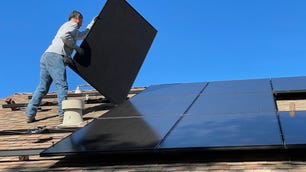If you can’t afford solar panels, you still might be able to get solar power as long as you live in the right spot.
Community solar is a model of buying power that allows you to subscribe to power produced at a large solar array or farm located at another location in your utility’s service area.
Utilities often initiate community solar projects, but in some regions they might be operated by a third party. States that mandate that some portion of their energy mix come from locally sourced community solar typically have more programs, too. The federal government has also tucked funding for programs into the Inflation Reduction Act and there’s a strong push underway to make it easier for low and middle-income households to benefit from initiatives that reduce monthly energy expenses. However, some utility-initiated community solar programs can actually increase your energy bill, proving not all solar subscriptions are created equal.
The Solar Energy Industries Association estimates 6.5 gigawatts of community solar have been installed in the US as of the first quarter of 2024. These projects are spread across 41 states and Washington, D.C. with 19 states and D.C. implementing official policies and programs to encourage more community solar. SEIA expects the gigawatts produced through community solar to double over the next half decade.
What is community solar?
Daniella Gray, head of customer relations at Altus Power, which develops and operates community solar projects across the country, said they often take the form of hundreds or thousands of panels over a parking lot, a contaminated “brownfield” or warehouse roof.
“Every situation is a little different depending on who we’re working with,” she explained. “Maybe somebody has a little extra roof space that they’re not using for anything else and it is a good candidate for solar.”
Altus might then lease that roof space and sell the power to subscribers in the community.

Watch this: New Solar Shingles You May Not Even Notice
“The panels are connected to the local utility grid … and the clean energy that’s being generated is getting sent directly to the grid and so the community really is benefitting from there being more clean energy.”
Subscribers benefit from the programs because the renewable energy generated is cheaper, in part because of subsidies and incentives from local, state and federal governments.
Community Solar by State
A number of states have implemented laws that enable community solar programs to exist and compel utilities to integrate them into their energy mix. Other states have gone further to mandate that a certain amount of community solar be installed by set deadlines, while others provide funding for projects.
The most comprehensive data on community solar across the US was compiled by the National Renewable Energy Laboratory in January 2022. It found that over 70%, in terms of capacity in megawatts, can be found in the four leading states: Florida, Minnesota, New York and Massachusetts.
Interestingly, much community solar development has occurred in states like Florida that have yet to pass any related legislation, where utilities and power cooperatives have taken the initiative on their own. Here’s a breakdown of where projects have been completed as of December 2021. The sector has been growing rapidly the past two years, so it’s possible many of these figures have changed.
Top states for community solar
States planning to implement community solar
The community solar landscape is growing and shifting rapidly. New Mexico and Hawaii are among the most recent to enact community solar legislation and are likely to move up in the above table in coming years.
Most states without community solar laws in place have at least seen some sort of legislation introduced in their statehouses. Community solar bills were introduced in Michigan in April but failed to advance in the state legislature. The situation has been similar in Wisconsin, Pennsylvania, Alaska and Montana in recent years.
Gray says moves by the California legislature promise to make community solar more viable in the most populous state, and a similar modification is also happening to a long-running program in Minnesota.
How to join a community solar program
Gray says participating in community solar is as simple as reaching out to a provider to see if they work with your local utility. If the answer is yes, all you need to provide is your account info with your utility. The last steps are signing a contract and figuring out payment arrangements if the community solar program doesn’t already consolidate billing with your utility.
Brandon Smithwood, senior director of policy at community solar company Dimension Renewable Energy, said many electric co-ops have been early adopters of community solar, whereas investor-owned utilities have typically had to be compelled to adopt similar programs through state legislation.
“It’s a minority of folks that can actually put solar on their roof and community solar is the option for everyone else,” he said.
In most cases, community solar credits will simply show up on your monthly utility bill, functioning like a monthly discount or rebate. Occasionally, subscribers may have to pay monthly bills from both their utility and community solar program, but the credits will also still be applied to their energy bill, providing a net savings.
EnergySage offers a tool that allows you to search for community solar programs by zip code.
“This is something that’s been available to a relatively small amount of Americans that’s going to become a much more common consumer product,” Smithwood said. “It’s a way to do good while also doing well.”
Pros and cons of community solar
Community solar can be hard to understand conceptually if you’re new to the topic, but participating in programs is simple. Still, there are some things to consider before enrolling.
Pros
- Community solar displaces fossil fuels from the energy mix resulting in cleaner air and fewer carbon emissions.
- Programs are designed to reduce energy bills and in particular to benefit low and middle-income families. (See a key exception below.)
- It’s one way to benefit from solar energy if you’re a renter or in a situation that doesn’t allow for installing solar panels yourself.
- Community solar developers lease land for a substantial amount providing farmers (and other property owners) a source of income. “This is the way to keep the farm as a farm and keep it in the family,” Smithwood explained.
Cons
- Gray said people often presume community solar is a scam because it seems to lower utility bills and do good for the environment at no cost to them.
- In some regions, particularly in the south, monopoly utilities offer community solar but pricing isn’t favorable. “To date the way that they price those products, it’s been more of a premium product,” said Jill Kysor at the Southern Environmental Law Center.
- Billing can be confusing if there isn’t consolidated billing in place and people have to worry about paying two bills tied to their electricity use.
FAQs
How many states have community solar programs?
As of 2023, community solar programs of some sort are available in 41 states and Washington, D.C. However, availability still requires participation from individual local utilities in many cases.
Can you make money with community solar?
Community solar rarely results in actual cash in your pocket, but its benefits include reduced monthly energy bills, credits or rebates.





















+ There are no comments
Add yours